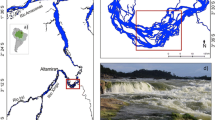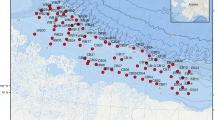Abstract
We compared water chemistry and environmental data with midge assemblage data, using multivariate analysis to assess the environmental gradients that limit midge (Chironomidae, Chaoboridae and Ceratopogonidae) distributions in the Hudson Bay Lowlands, northeastern Manitoba, Canada. Midge remains, comprising 62 taxa, were obtained from surficial sediments of 63 ponds. Ponds were sampled to maximize the salinity gradient. Specific conductance ranged from 46 to 29,000 μS cm−1. Proximity to the coast was a principal determinant of pond salinity, with ponds closer to Hudson Bay shoreline more saline that those farther away. Multivariate analysis indicated that midge distributions have a significant relationship (\( {\text{r}}_{\text{boot}}^{2} = 0.68 \)) with salinity in the data set. This work will allow paleolimnological inferences of midge community responses to changing sea level (i.e. salinity) via isostatic rebound within the Hudson Bay Lowlands, and will provide essential limnological information to scientists and managers in a region where understanding of aquatic ecosystems is limited. One undescribed midge taxon was dominant in ponds with the highest salinities and may be a key indicator for inferring highly saline environments.





Similar content being viewed by others
References
Barley EM, Walker IR, Kurek J, Cwynar LC, Mathewes RW, Gajewski K, Finney BP (2006) A northwest North American training set: distribution of freshwater midges in relation to air temperature and lake depth. J Paleolimnol 36:295–314
Bello RL, Smith JD (1990) The effect of weather variability on the energy balance of a lake in the Hudson Bay Lowlands, Canada. Arctic Alpine Res 22:98–107
Bos DG, Pellatt MG (2012) The water chemistry of shallow ponds around Wapusk National Park of Canada, Hudson Bay Lowlands. Can Water Resour J 37:163–175. doi:10.4296/cwrj2011-900
Brook RB, Thompson B, Sparling B, O’Brien DO (2002) Wapusk national park ecological integrity statement vegetation map extension. Contract # C7110-C00-0013 for Parks Canada
Brooks SJ, Birks HJB (2001) Chironomid-inferred air temperatures from lateglacial and Holocene sites in northwest Europe: progress and problems. Quat Sci Rev 20:1723–1741
Brooks SJ, Langdon PG, Heiri O (2007) The identification and use of Palaearctic Chironomidae larvae in palaeoecology. QRA Technical Guide No. 10, Quaternary Res, London. 276 pp
Duguay CR, Lafleur PM (2003) Determining depth and ice thickness of shallow sub-Arctic lakes using space-borne optical and SAR data. Int J Remote Sens 24:475–489
Eggermont H, Heiri O, Verschuren D (2006) Fossil Chironomidae (Insecta: Diptera) as quantitative indicators of past salinity in African lakes. Quat Sci Rev 25:1966–1994
Glew J (1991) Miniature gravity corer for recovering short sediment cores. J Paleolimnol 5:285–287
Hammer UT, Sheard JS, Kranabetter J (1990) Distribution and abundance of littoral benthic fauna in Canadian prairie saline lakes. Hydrobiologia 197:173–192
Heinrichs ML, Walker IR (2006) Fossil midges and palaeosalinity: potential as indicators of hydrological balance and sea-level change. Quat Sci Rev 25:1948–1965
Heiri O, Lotter AF (2001) Effect of low count sums on quantitative environmental reconstructions: an example using subfossil chironomids. J Paleolimnol 26:343–350
Jongman RHG, ter Braak CJF, van Tongeren OFR (1987) Data analysis in community and landscape ecology. Pudoc, Wageningen
Juggins S (2003) C2 version 1.4. University of Newcastle
Korhola A, Olander H, Blom T (2000) Cladoceran and chironomid assemblages as quantitative indicators of water depth in subarctic Fennoscandian lakes. J Paleolimnol 24:43–54
Lafleur TE, Rouse WR (1995) Energy partitioning at tree-line forest and tundra sites and its sensitivity to climate change. Atmos Ocean 33:121–133
Langdon PG, Holmes N, Caseldine CJ (2008) Environmental controls on modern chironomid faunas from NW Iceland and implications for reconstructing climate change. J Paleolimnol 40:273–293
Luoto T (2011) The relationship between water quality and chironomid distribution in Finland—A new assemblage-based tool for assessments of long-term nutrient dynamics. Ecol Indic 11:255–262
Martini IP (1989) The Hudson Bay Lowland: major geological features and assets. Geol Mijnbouw 68:25–34
Medeiros AS, Quinlan R (2011) The distribution of the Chironomidae (Insecta:Dipera) along multiple environmental gradients in lakes and ponds of the eastern Canadian Arctic. Can J Fish Aquat Sci 68:1511–1527
National Climate Data and Information Archive (2011) Environment Canada. Retrieved August 20, 2011, from http://climate.weatheroffice.gc.ca
Natural Resources Canada (2007) Atlas of Canada. Retrieved 22 Aug 2011, from http://www.atlas.gc.ca/site/index
Olander H, Birks HJB, Korhola A, Blom T (1999) An expanded calibration model for inferring lakewater and air temperatures from fossil chironomid assemblages in northern Fennoscandia. Holocene 9:279–294
Oliver DR, Roussel ME (1983) The insects and arachnids of Canada, Part 11: the Genera of Larval Midges of Canada, Diptera: Chironomidae. Research Branch, Agriculture Canada, Publication 1746, 263 pp
Pienitz R, Vincent W (2000) Effects of climate change relative to ozone depletion on UV exposure in subarctic lakes. Nature 404:484–487
Quinlan R, Smol JP (2001) Setting minimum head capsule abundance and taxa deletion criteria in chironomid-based inference models. J Paleolimnol 26:327–342
ter Braak CJF (1991) CANOCO version 4.5. Agricultural Mathematics Group, University of Wageningen, Wageningen, The Netherlands
Timms BV, Hammer UT, Sheard JW (1986) A study of benthic communities in some saline lakes in Saskatchewan and Alberta, Canada. Int Rev Gesamten Hydrobiologie 71:759–777
Verschuren D, Cummings BF, Laird KR (2004) Quantitative reconstruction of past salinity variations in African lakes using fossil midges (Diptera: Chironomidae): assessment of inference models in space and time. Can J Fish Aquat Sci 61:986–998
Walker IR (1988) Late-Quaternary Palaeoecology of Chironomidae (Dipera: Insecta) from Lake Sediments in British Columba. Ph.D. thesis, Simon Fraser University, Burnaby, 204 pp
Walker IR (2000) The WWW field guide to subfossil midges. Frequently accessed in 2010 and 2011 from http://www.paleolab.ca/wwwguide
Walker IR, Smol JP, Egstrom D, Birks HJB (1991) An assessment of Chironomidae as quantitative indicators of past climatic change. Can J Fish Aquat Sci 48:975–987
Walker IR, Wilson SE, Smol JP (1995) Chironomidae (Diptera): quantitative palaeosalinity indicators for lakes of western Canada. Can J Fish Aquat Sci 52:950–960
Walker IR, Levesque AJ, Cwynar LC, Lotter AF (1997) An expanded surface-water palaeotemperature inference model for use with fossil midges from eastern Canada. J Paleolimnol 18:165–178
Wiederholm T (1980) Effects of dilution on the benthos of an alkaline lake. Hydrobiologia 68:199–207
Wiederholm T (1983) Chironomidae of the Holarctic Region. Keys and Diagnoses. Part 1. Larvae. Entomol Scand Suppl 19:1–457
Wolf D, Volker K, Johann W, Fei PZ (2006) A reanalysis and reinterpretation of geodetic and geological evidence of glacial-isostatic adjustment in the Churchill region, Hudson Bay. Surv Geophys 27:19–61
Woodward CA, Shulmeister J (2006) New Zealand chironomids as proxies for human-induced and natural environmental change: Transfer functions for temperature and lake production (chlorophyll a). J Paleolimnol 36:407–429
Zhang E, Jones R, Bedford A, Langdon P, Tang H (2007) A chironomid-based salinity inference model from lakes on the Tibetan Plateau. J Paleolimnol 38:477–479
Acknowledgments
Thanks to all who helped in the laboratory, picking nearly 4,000 sub-fossil head capsules from sediments (Kim Louden, Courtney Ek, Matthew Meehan, Kelsey Mills, Jordan Wu, Brooke McConnell, and Omar Mwangrai). We also thank the staff at the Churchill Northern Studies Centre for logistical support during this project. Thanks also to Larry Gogal and Gogal Air for the lift.
Author information
Authors and Affiliations
Corresponding author
Rights and permissions
About this article
Cite this article
Dickson, T.R., Bos, D.G., Pellatt, M.G. et al. A midge-salinity transfer function for inferring sea level change and landscape evolution in the Hudson Bay Lowlands, Manitoba, Canada. J Paleolimnol 51, 325–341 (2014). https://doi.org/10.1007/s10933-013-9714-x
Received:
Accepted:
Published:
Issue Date:
DOI: https://doi.org/10.1007/s10933-013-9714-x




